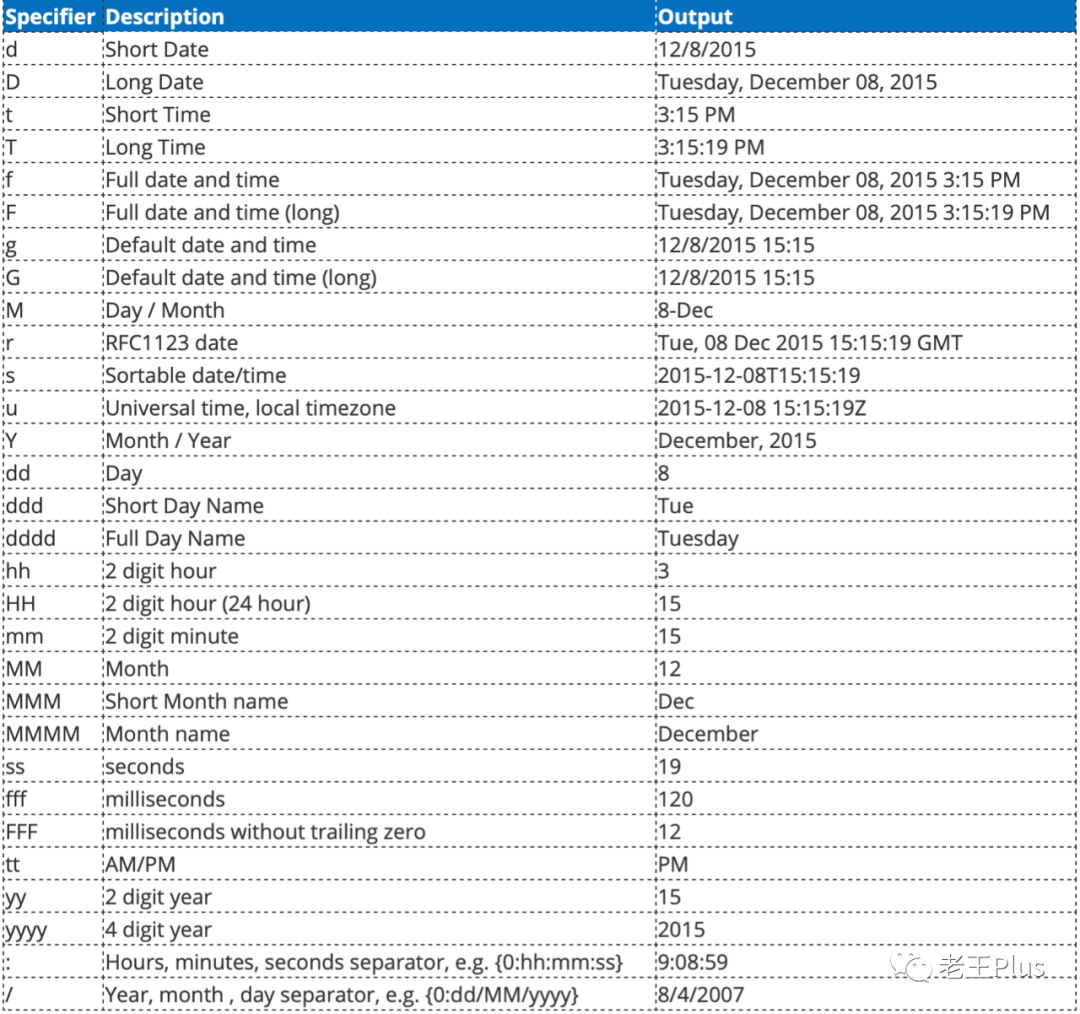C#中DateTime实现的功能,比我们想像的要多?
DateTime,就是一个世界的大融合。
日期和时间,在我们开发中非常重要。DateTime在C#中,专门用来表达和处理日期和时间。
本文算是多年使用DateTime的一个总结,包括DateTime对象的整体应用,以及如何处理不同的区域、时区、格式等内容。
一、什么是DateTime
跟我们想的不一样,DateTime不是一个类(class),而是一个结构(struct),它存在于System命名空间下,在Dotnet Core中,处于System.Runtime.dll中。
看一下DateTime的定义:
public struct DateTime : IComparable, IComparable<DateTime>, IConvertible, IEquatable<DateTime>, IFormattable, System.Runtime.Serialization.ISerializable
从定义可以知道,DateTime实现了IComparable、IConvertible、IEquatable、IFormattable、ISerializable。因此,DateTime可以让我们使用有关日期和时间的很多相关信息。
二、构造
初始化一个DateTime对象,C#提供了11种方式进行初始化,根据需要,可以使用年月日时分秒,以及Ticks。
Ticks是C#里一个独特的定义,它是以公历0001年1月1日00:00:00.000以来所经历的以100纳秒为间隔的间隔数。我们知道,纳秒、微秒、毫秒和秒之间都是1000倍的关系,所以,1毫秒等于10000Ticks。这个数字很重要。在C#到Javascript时间转换时,需要很清楚这个对应关系。
DateTime date1 = new DateTime(2020, 7, 14);
DateTime date2 = new DateTime(2020, 7, 14, 14, 23, 40);
DateTime date3 = new DateTime(637303334200000000);
三、静态字段
DateTime包括三个静态字段:
MinValue - DateTime的最小值,对应公历0001年1月1日00:00:00.000,Ticks为0;
MaxValue - DateTime的最大值,对应公历9999看12月31日23:59:59.999,Ticks为3155378975999999999;
UnixEpoch - Unix、Javascript下的时间起点,对应公历1970年1月1日00:00:00.000,Ticks为621355968000000000;
在Javascript中,时间保存的是从UnixEpoch开始,即从1970年1月1日00:00:00.000开始到现在的毫秒数。所以,C#时间到Javascript时间的转换,可以用以下代码:
public static long ToUnixTicks(this DateTime time)
{
return (long)TimeSpan.FromTicks(time.Ticks - DateTime.UnixEpoch.Ticks).TotalMilliseconds - TimeZoneInfo.Local.GetUtcOffset(time).Hours * 60 * 60 * 1000;
}
在Javascript中引入时间:
var time = new Date().setTime(unix_ticks);
就完成了转换。
四、方法
DateTime提供了很多种方法来操作DateTime对象,用于处理诸如向日期添加天数、小时、分钟、秒、日期差异、从字符串解析到datetime对象、获得通用时间等等。这儿就不详细说了,需要了可以查微软文档,很详细。
给几个例子:
TimeSpan duration = new System.TimeSpan(30, 0, 0, 0);
DateTime newDate1 = DateTime.Now.Add(duration);
DateTime today = DateTime.Now;
DateTime newDate2 = today.AddDays(30);
string dateString = "2020-07-14 14:23:40";
DateTime dateTime12 = DateTime.Parse(dateString);
DateTime date1 = new System.DateTime(2020, 7, 13, 14, 20, 10);
DateTime date2 = new System.DateTime(2020, 7, 14, 14, 25, 40);
DateTime date3 = new System.DateTime(2020, 7, 14, 14, 25, 40);
TimeSpan diff1 = date2.Subtract(date1);
DateTime date4 = date3.Subtract(diff1);
TimeSpan diff2 = date3 - date2;
DateTime date5 = date2 - diff1;
五、属性
DateTime提供了年月日时分秒、以及其它一些属性,用来方便提取日期中的细节。
DateTime myDate = new DateTime(2020, 7, 14, 14, 23, 40);
int year = myDate.Year;
int month = myDate.Month;
int day = myDate.Day;
int hour = myDate.Hour;
int minute = myDate.Minute;
int second = myDate.Second;
int weekDay = (int)myDate.DayOfWeek;
string weekString = myDate.DayOfWeek.ToString();
其中,DayOfWeek,是用来判断日期是星期几的,它是一个枚举值。注意,按照惯例,一周是从周日开始的,所以,0表示周日,6表示周六。
DateTimeKind,用来定义实例表示的时间是基于本地时间(LocalTime)、UTC时间(UTC)或是不指定(Unspecified)。
在大多数情况下,我们定义时间就直接定义年月日时分秒,例如下面:
DateTime myDate = new DateTime(2020, 7, 14, 14, 23, 40);
这种定义下,这个时间就是Unspecified的。
在使用时,如果应用过程中不做时间转换,始终以这种方式用,那不会有任何问题。但在某些情况下,时间有可能会发生转换,例如跨国应用的时间处理,再例如MongoDB,在数据库保存数据时,强制使用UTC时间。这种情况下,处理时间就必须采用LocalTime或UTC时间:
DateTime myDate = new DateTime(2020, 7, 14, 14, 23, 40, DateTimeKind.Local);
或
DateTime myDate = new DateTime(2020, 7, 14, 14, 23, 40, DateTimeKind.Unspecified);
否则,在时间类型不确定的情况下,时间转换会出现问题。
看看下面的例子:
DateTime myDate = new DateTime(2020, 7, 14, 14, 23, 40);
var date1 = myDate.ToLocalTime();
Console.WriteLine(date1.ToString());
/* 7/14/2020 22:23:40 PM */
var date2 = myDate.ToUniversalTime();
Console.WriteLine(date2.ToString());
/* 7/14/2020 6:23:40 AM */
当使用ToLocalTime方法时,Unspecified时间会认为自己是UTC时间,而当使用ToUniversalTime时,Unspecified时间又会认为自己是LocalTime时间,导致时间上的转换错误。
关于MongoDB处理时间的相关内容,可以去看我的另一个文章:MongoDB via Dotnet Core数据映射详解
六、时间对象的加减及比较
DateTime时间对象的加减及比较非常方便。看例子:
DateTime date1 = new System.DateTime(2020, 7, 14);
TimeSpan timeSpan = new System.TimeSpan(10, 5, 5, 1);
DateTime addResult = date1 + timeSpan;
DateTime substarctResult = date1 - timeSpan;
DateTime date2 = new DateTime(2020, 7, 14);
DateTime date3 = new DateTime(2020, 7, 15);
bool isEqual = date2 == date3;
七、日期的格式化
日期的格式化是相关DateTime网上询问和查找最多的内容。
有这么一个表:

对照这个表就可以:
date.ToString("yyyy-MM-dd HH:mm:ss");
八、阴历
DateTime本身依赖于日历Calendar类。Calendar是一个抽象类,在System.Globalization命名空间下,也在System.Runtime.dll中。而在Calendar类下面,提供了很多不同类型的日历。跟我们有关系的,是中国的阴历ChineseLunisolarCalendar。
使用也很简单:
Calendar calendar = new ChineseLunisolarCalendar();
DateTime date = new DateTime(2020, 06, 24, calendar);
/* 7/14/2020 00:00:00 AM */
嗯嗯,经常看阴历的伙伴们会看出一点问题:今天是阴历5月24,为什么这儿写的是6月24呢?这个是因为今天闰4月,所以,阴历5月实际是这一个阴历年的第6个月。
那如何判断哪个月是否闰月呢?
Calendar calendar = new ChineseLunisolarCalendar();
bool is_leapYear = calendar.IsLeapYear(2020);
bool is_leapMonth = calendar.IsLeapMonth(2020, 5);
bool is_leapDay = calendar.IsLeapDay(2020, 5, 26);
同样,我们也可以用公历转阴历:
DateTime date = DateTime.Now;
Calendar calendar = new ChineseLunisolarCalendar();
int year = calendar.GetYear(date);
/* 2020 */
int month = calendar.GetMonth(date);
/* 6 */
int day = calendar.GetDayOfMonth(date);
/* 24 */
以上就是全部内容了。
有没有发现,微软实现的功能,比我们想像的要多?


被网易云刷屏的人格颜色测试,我来总结下……爆火,点击查看>>>

【限时删】刘*55页ppt大瓜,比项*醒的还要精彩!
